Shizuoka Prefecture
Shizuoka Prefecture (静岡県, Shizuoka-ken) is a prefecture of Japan located in the Chūbu region of Honshu.[1] As of December 2019, Shizuoka Prefecture has a population of 3,637,998 and has a geographic area of 7,777.42 km2 (3,002.88 sq mi). Shizuoka Prefecture borders Kanagawa Prefecture to the east, Yamanashi Prefecture to the northeast, Nagano Prefecture to the north, and Aichi Prefecture to the west.
Shizuoka Prefecture
静岡県 | |
|---|---|
| Japanese transcription(s) | |
| • Japanese | 静岡県 |
| • Rōmaji | Shizuoka-ken |
 Flag  Symbol | |
| Anthem: Shizuoka kenka and Fuji yo yume yo tomo yo | |
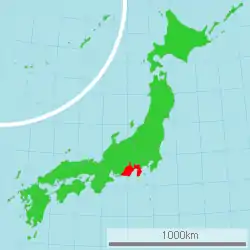 | |
| Coordinates: 34°55′N 138°19′E | |
| Country | Japan |
| Region | Chūbu (Tōkai) |
| Island | Honshu |
| Capital | Shizuoka |
| Largest city | Hamamatsu |
| Subdivisions | Districts: 5, Municipalities: 35 |
| Government | |
| • Governor | Heita Kawakatsu |
| Area | |
| • Total | 7,777.42 km2 (3,002.88 sq mi) |
| • Rank | 13th |
| Highest elevation | 3,778 m (12,395 ft) |
| Population (1 December 2019) | |
| • Total | 3,637,998 |
| • Rank | 10th |
| • Density | 470/km2 (1,200/sq mi) |
| • Dialect | Shizuoka dialect |
| ISO 3166 code | JP-22 |
| Website | www |
| Symbols | |
| Bird | Japanese paradise flycatcher (Terpsiphone atrocaudata) |
| Flower | Azalea (Rhododendron) |
| Tree | Sweet osmanthus (Osmanthus fragrans var. aurantiacus) |
Shizuoka is the capital and Hamamatsu is the largest city in Shizuoka Prefecture, with other major cities including Fuji, Numazu, and Iwata.[2] Shizuoka Prefecture is located on Japan's Pacific Ocean coast and features Suruga Bay formed by the Izu Peninsula, and Lake Hamana which is considered to be one of Japan's largest lakes. Mount Fuji, the tallest volcano in Japan and cultural icon of the country, is partially located in Shizuoka Prefecture on the border with Yamanashi Prefecture. Shizuoka Prefecture has a significant motoring heritage as the founding location of Honda, Suzuki, and Yamaha, and is home to the Fuji International Speedway.
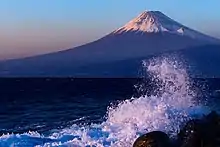
History
Shizuoka Prefecture was established from the former Tōtōmi, Suruga and Izu provinces.[3]
The area was the home of the first Tokugawa shōgun. Tokugawa Ieyasu held the region until he conquered the lands of the Hōjō clan in the Kantō region and placed land under the stewardship of Toyotomi Hideyoshi. After becoming shōgun, Tokugawa took the land back for his family and put the area around modern-day Shizuoka city under the direct supervision of the shogunate. With the creation of Shizuoka han in 1868, it once again became the residence of the Tokugawa family.
Geography
Shizuoka Prefecture is an elongated region following the coast of the Pacific Ocean at the Suruga Bay. In the west, the prefecture extends deep into the Japan Alps. In the east, it becomes a narrower coast bounded in the north by Mount Fuji, until it comes to the Izu Peninsula, a popular resort area pointing south into the Pacific.
As of April 2012, 11% of the total land area of the prefecture was designated as Natural Parks, namely the Fuji-Hakone-Izu and Minami Alps National Parks; Tenryū-Okumikawa Quasi-National Park; and four Prefectural Natural Parks.[4]
Tokai earthquakes
Throughout history, a disastrous earthquake called the Tokai earthquake has hit Shizuoka every 100 to 150 years. On 15 March 2011, Shizuoka Prefecture was hit with a magnitude 6.2 earthquake approximately 42 km (26 mi) NNE of Shizuoka City.
Municipalities
Since 2010, Shizuoka has consisted of 35 municipalities: 23 cities and 12 towns.
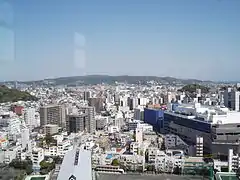
.jpg.webp)
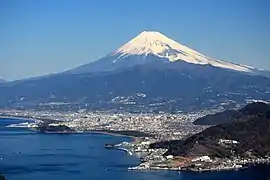 Numazu and Mount Fuji
Numazu and Mount Fuji Fujinomiya
Fujinomiya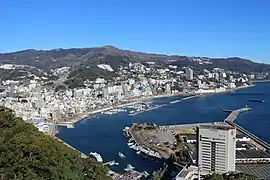 Atami
Atami

Mergers
After the introduction of modern municipalities in 1889, Shizuoka consisted of 337 municipalities: 1 (by definition: district-independent) city and 23 districts with 31 towns and 305 villages. The Great Shōwa mergers of the 1950s reduced the total from 281 to 97 between 1953 and 1960, including 18 cities by then. The Great Heisei mergers of the 2000s combined the 74 remaining municipalities in the year 2000 into the current 35 by 2010.
List of governors of Shizuoka (since 1947)
| # | Name (Birth–Death) |
Term of office | Political Party | |
|---|---|---|---|---|
| 1 | Takeji Kobayashi (小林武治) (1899-1988) |
23 April 1947 | 22 April 1951 | Independent |
| 2 | Toshio Saito (斎藤寿夫) (1908-1999) |
1 May 1951 | 8 January 1967 | Liberal Party (1951-1959) Liberal Democratic Party (1959-1967) |
| 3 | Yutaro Takeyama (竹山祐太郎) (1901-1982) |
31 January 1967 | 24 June 1974 | LDP |
| 4 | Keizaburo Yamamoto (山本敬三郎) (1913-2006) |
10 June 1974 | 6 July 1986 | LDP |
| 5 | Shigeyoshi Saito (斉藤滋与史) (1918-2018) |
7 July 1986 | 23 June 1993 | LDP |
| 6 | Yoshinobu Ishikawa (石川嘉延) (born in 1940) |
3 August 1993 | 17 June 2009 | Independent |
| 7 | Heita Kawakatsu (川勝平太) (born in 1948) |
7 July 2009 | Incumbent | Independent |
Transportation
Rail
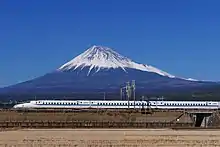

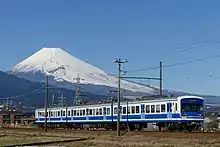
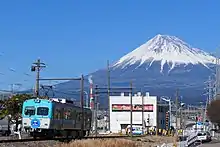
- JR East
- Tōkaidō Line (Atami–Odawara)
- Itō Line
- JR Central
- Tōkaidō Shinkansen
- Tōkaidō Line (Atami–Toyohashi)
- Gotenba Line
- Minobu Line
- Iida Line
- Izukyū
- Izuhakone Railway
- Daiyūzan Line
- Sunzu Line
- Gakunan Railway
- Shizuoka Railway
- Ōigawa Railway
- Enshū Railway
- Tenryū Hamanako Railroad
Expressways
- Tōmei Expressway
- Shin-Tōmei Expressway
- Chūbu-Ōdan Expressway
- Izu-Jūkan Expressway
- San-en Nanshin Expressway
Toll roads
- Shizuoka East-West Road
- Shizuoka South-North Road
- West Fuji Road (not a toll road anymore as of 2012)
- Fujinomiya Road
- Nishi-Fuji Road
National highways
- National Route 1
- National Route 42
- National Route 52
- National Route 135
- National Route 136
- National Route 138
- National Route 139
- National Route 149
- National Route 150
- National Route 152
- National Route 246
- National Route 257
- National Route 301
- National Route 362
- National Route 414
- National Route 469
- National Route 473
- National Route 474
Airports
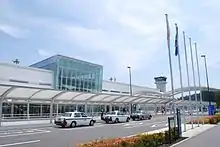
- Shizuoka Airport
Ports
- Shimizu Port
- Atami Port and Shimoda Port - Mainly ferry route to Izu Island
- Numazu Port
Education
Universities
National universities
- Hamamatsu University School of Medicine
- Shizuoka University
- Graduate University for Advanced Studies (Mishima Campus, National Institute of Genetics)
Public universities
- Shizuoka University of Art and Culture
- University of Shizuoka
Private universities
- Fuji Tokoha University
- Hamamatsu University
- Hamamatsu Gakuin University
- Juntendo University (Mishima Campus)
- Nihon University (Mishima Campus)
- Shizuoka Eiwa Gakuin University
- Shizuoka Institute of Science and Technology
- Shizuoka Sangyo University
- Shizuoka University of Welfare
- Tokyo Women's Medical University (Daito Campus)
- Tokai University (Shimizu and Numazu Campuses)
- Tokoha Gakuen University
Senior high schools
- Numazu Commercial High School
- Shizuoka Prefectural Susono High School
- Shizuoka Prefectural High School
Sports

The sports teams listed below are based in Shizuoka.
Basketball
- San-en NeoPhoenix
Motorsport
Rugby
- Yamaha Júbilo (Iwata)
Football
- Shimizu S-Pulse (Shimizu, Shizuoka)
- Júbilo Iwata (Iwata)
- Matches between the above two teams, both currently in the top flight of the J. League, are known as the Shizuoka Derby.
- Honda F.C. (Hamamatsu)
- Azul Claro Numazu (Numazu)
- Fujieda MYFC (Fujieda)
Volleyball
- Toray Arrows (men's volleyball team) (Mishima city)
Tourism
Museums
- Shizuoka Prefectural Museum of Art
- Museum of Natural and Environmental History, Shizuoka
Theme parks
Festivals and events
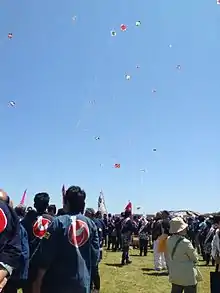
- Shimoda Black Ship Festival, held in May
- Shimizu Port Festival, held on August 5 to 7
- Shizuoka Festival, held in April
- Daidogei World Cup in central Shizuoka City, held in November
- Enshu Daimyo Festival in Iwata, held in April
- Numazu Festival, held in July
- Mishima Festival, held in August
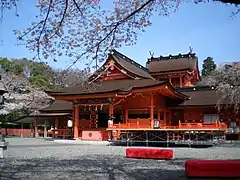 Fujisan Hongū Sengen Taisha Fujinomiya
Fujisan Hongū Sengen Taisha Fujinomiya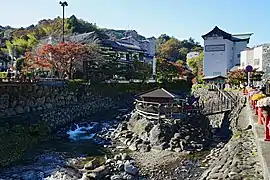 Shuzenji Onsen Izu
Shuzenji Onsen Izu Sunpu Castle Shizuoka Aoi-ku
Sunpu Castle Shizuoka Aoi-ku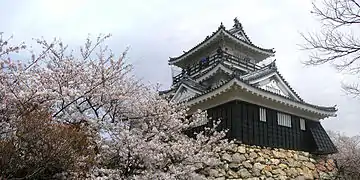 Hamamatsu Castle Hamamatsu Naka-ku
Hamamatsu Castle Hamamatsu Naka-ku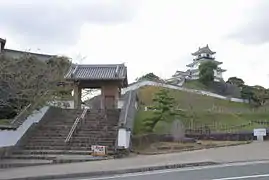 Kakegawa Castle Kakegawa
Kakegawa Castle Kakegawa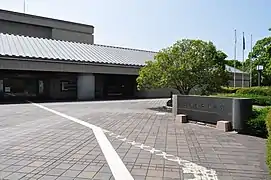 Shizuoka Prefectural Museum of Art Shizuoka Suruga-ku
Shizuoka Prefectural Museum of Art Shizuoka Suruga-ku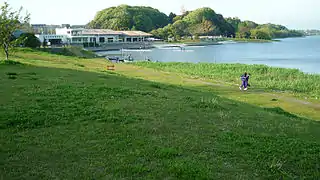 Lake Sanaru Hamamatsu Nishi-ku
Lake Sanaru Hamamatsu Nishi-ku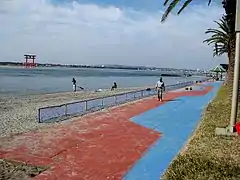 Lake Hamana Hamamatsu Nishi-ku
Lake Hamana Hamamatsu Nishi-ku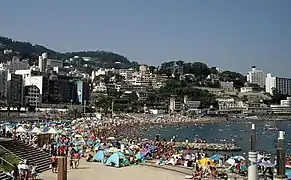 Atami Sun Beach Atami
Atami Sun Beach Atami Kawazu Cherry blossom Kamo District Kawazu
Kawazu Cherry blossom Kamo District Kawazu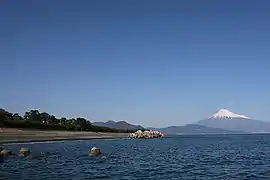 Miho no Matsubara Shizuoka Shimizu-ku
Miho no Matsubara Shizuoka Shimizu-ku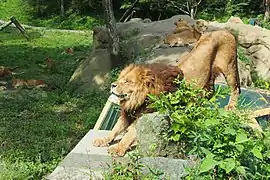 Fuji Safari Park Susono
Fuji Safari Park Susono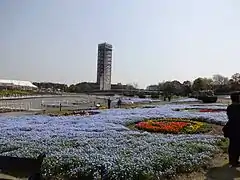 Hamanako Garden Park Hamamatsu Nishi-ku
Hamanako Garden Park Hamamatsu Nishi-ku Snowtown Yeti & Mount Fuji Susono
Snowtown Yeti & Mount Fuji Susono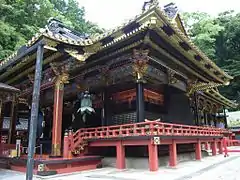 Kunōzan Tōshō-gū Shizuoka Suruga-ku
Kunōzan Tōshō-gū Shizuoka Suruga-ku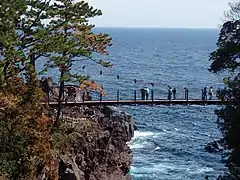 Jogasaki Coast Itō
Jogasaki Coast Itō
Notes
- Nussbaum, Louis-Frédéric. (2005). "Shizuoka-ken" in Japan Encyclopedia, p. 876, p. 876, at Google Books; "Chūbu" in p. 126, p. 126, at Google Books
- Nussbaum, "Shizuoka" at p. 876, p. 876, at Google Books.
- Nussbaum, "Provinces and prefectures" at p. 780, p. 780, at Google Books.
- "General overview of area figures for Natural Parks by prefecture" (PDF). Ministry of the Environment. 1 April 2012. Retrieved 10 August 2014.
- "About Air Park Japan Air Self-Defense Force Hamamatsu Public Information Building - Shizuoka Travel Guide | Planetyze". Planetyze. Retrieved 2017-11-17.
- "About Shimizu Sushi Museum - Shizuoka Travel Guide | Planetyze". Planetyze. Retrieved 2017-11-17.
References
- Nussbaum, Louis-Frédéric and Käthe Roth. (2005). Japan encyclopedia. Cambridge: Harvard University Press. ISBN 978-0-674-01753-5; OCLC 58053128
